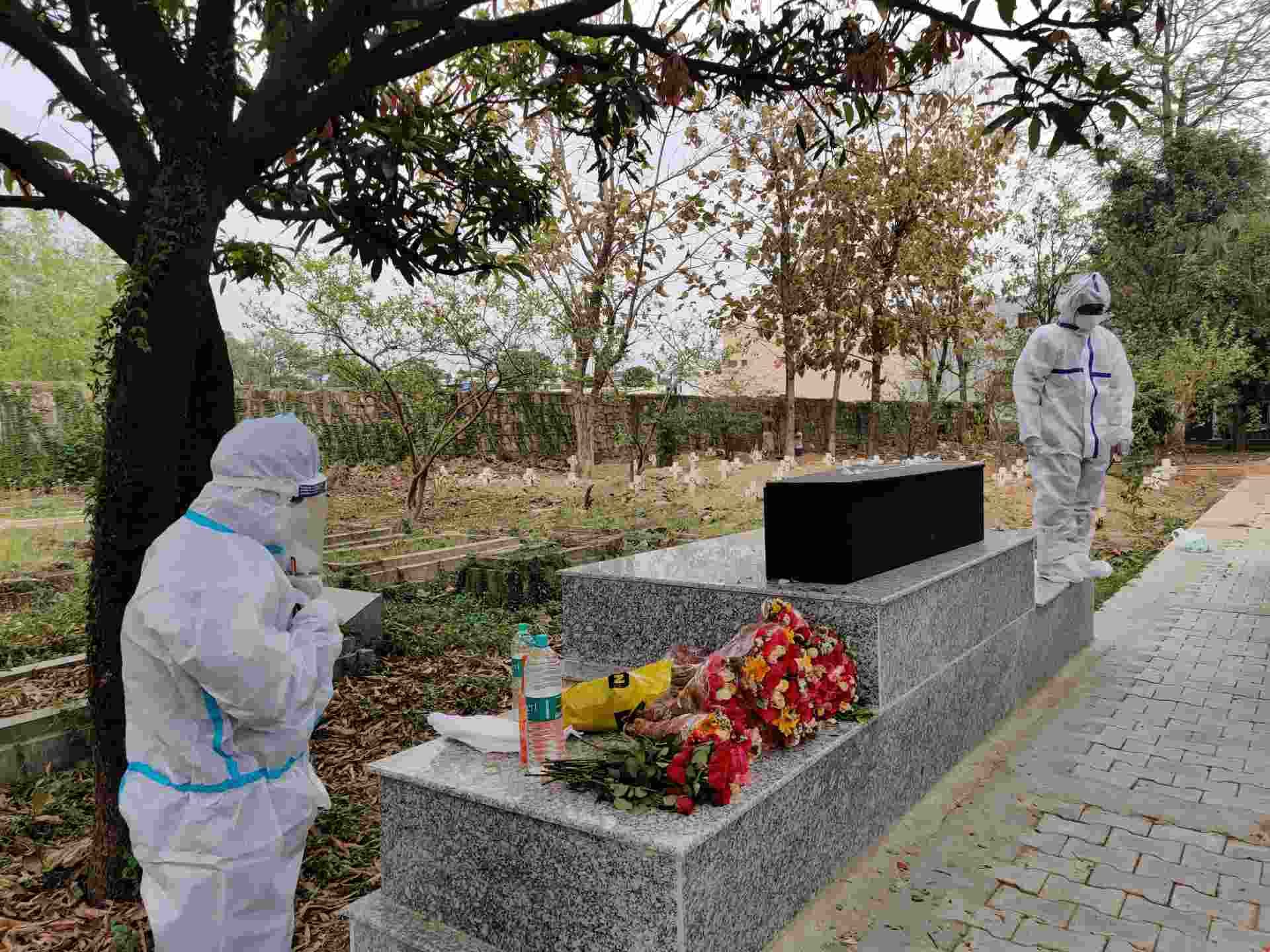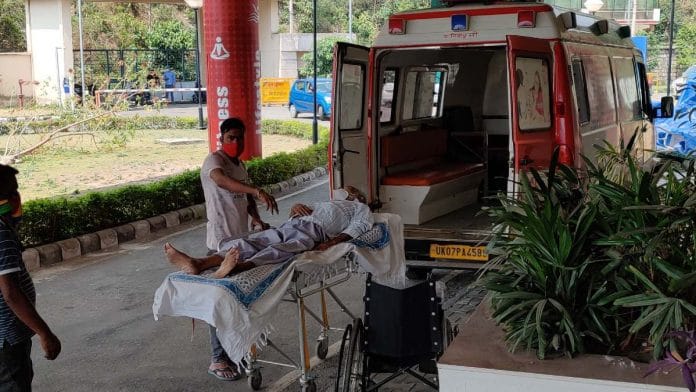Dehradun: In late March, before the Kumbh Mela began in Haridwar, Uttarakhand capital Dehradun was notching less than 100 cases daily. Fast forward to 12 May, roughly a week after the month-long congregation of devotees on the banks of the Ganga ended, the district recorded 2,352 cases, or 30 per cent of the state’s total.
The number was 2,419 on 9 May, 1,857 on 10 May, and 2,201 on 11 May.
Dehradun’s cumulative total of Covid cases was 93,849 as of 12 May, or 35 per cent of the state’s 2,64,683.
Dehradun, which borders Haridwar to its south, is by far the state’s worst-hit district. Not only has Dehradun emerged as a hotspot in the country, alongside Gurugram and Kolkata, Uttarakhand has also made its way to the top 10 states in terms of deaths due to the virus.
The Kumbh Mela, which draws lakhs of devotees to Haridwar, began in the first week of April, just as the second wave of coronavirus was picking up pace in India with more than one mutant strain in transmission.
Photos from the congregation showed blatant violations of masking and distancing guidelines as devotees thronged the river for a dip and gathered at the banks for aarti.
Holding the mela amid the pandemic was a decision that has been widely criticised, especially because of the sheer magnitude of participation. However, the authorities in Dehradun are certain the Covid surge in the district can’t completely be blamed on the Kumbh.
“The Kumbh Mela could have contributed to the surge in cases but it’s not as bad as people think. The celebrations ended a week ago, but cases are still low in Haridwar,” said Rajeev Dixit, the Dehradun nodal officer.
On 12 May, Haridwar recorded 913 cases, taking the total tally up to 41,101.
Dr S.K. Jha, who works at the Community Health Centre in Raipur, on the outskirts of Dehradun, agreed with Dixit.
“I don’t think we can blame the surge in cases on the Kumbh Mela. The situation isn’t that bad in Haridwar. I don’t think this analysis makes sense,” he said.
The Kumbh Mela was not even supposed to happen this year, but was advanced by a year owing to “astrological configurations”. Since the 19th century, the Kumbh’s role as a potential amplifier of disease has been a matter of study.
In 1895, an article in the Indian Medical Gazette titled ‘The Natural History of Haridwar Fair Cholera Outbreaks’ talks about how the two epidemics between 1858 and 1891 happened in “two of the three Kumbh years of that period”. A 1959 World Health Organization monograph has a section linking cholera outbreaks with the Kumbh Mela. Most recently, a 2015 article in Clinical Microbiology and Infection, a peer-reviewed journal, analysed the risk factors that allow the spread of infectious diseases at the Kumbh Mela.
Doctors and experts in Uttarakhand say the Covid situation in Dehradun is nothing unexpected. They point to the Kumbh as one of several factors that came together to catalyse a surge in the district.
Also Read: ‘Holy dip will wash away all infections’: Kumbh returnees are driving Rajasthan Covid graph up
What went wrong
Despite the pandemic having struck last year, and the second wave beginning to trigger a surge across India in April, Uttarakhand formed its high-powered task force to oversee the situation as recently as 11 May.
It comprises additional chief secretary Manisha Panwar, and secretaries Amit Singh Negi, Shailesh Bagauli and Pankaj Kumar Pandey. It also includes National Health Mission Uttarakhand director Sonika and the medical health and medical education director general for NHM Uttarakhand, Dr Bhargav Gaekwad.
Dehradun conducts roughly 10,000 tests daily, and had a positivity rate between 26 and 30 per cent over the past week.
In the first week of April, 26 samples collected in March were sent for genome sequencing, of which three were found to have mutations — the so-called UK strain (B.1.1.7) and the double mutant (B.1.617). Samples collected in April have not yet been sent for genome sequencing owing to the surge in cases that has overwhelmed the health department and testing labs.

“We are only seeing the tip of the iceberg. We only send 5 per cent of the positive samples for sequencing. It’s clear from the mutation that it’s already there in the community and is circulating daily. Given how the number of cases have spiked in March-end and April, the mutant has circulated well,” Dr Deepak Juyal, assistant professor at the state-run Doon Medical College, told ThePrint.
However, the strain is not the only factor to blame. Complacency, by the government and people, is to be blamed as well, say experts.
“There was no control over flights and trains coming to Uttarakhand from outside, the Kumbh Mela took place, Holi was celebrated, there were no restrictions on weddings,” said Dr D.D. Choudhury, national vice-president of the Indian Medical Association.
“The government was in a comfortable situation in the beginning of the year because they thought they beat Covid. I had warned them in October-November about the deadly second wave, but no one listened,” he added.
As of 13 May, Dehradun had 941 non-oxygen hospital beds, of which 672 were available, 1,960 oxygen beds of which 225 were available, and 701 ICU beds, all of which are occupied.
The majority of the district’s cases — around 11,000 — remain in home isolation, said Dixit, with the trend primarily attributed to mild symptoms among patients. Dixit believes this to be among the reasons behind the surge.
“Those in home isolation move around freely, endangering other members of their families. Dekh lenge aur dekha jayega ki wajeh se cases badh rahe hain (the ‘we’ll see’ mentality is driving up the cases),” he said.
Vaccination is another weak point. While there is no longer any hesitancy, shortage of doses is hampering the drive. The government got another batch of doses on 12 May, but this will last just six days.
“We have set up several places for a large number of people, around 20,000, to get vaccinated but we don’t have the supply for that,” Dixit said.
Owing to a shortage in the availability of Covishield and Covaxin, the two vaccines currently in circulation in India, the Uttarakhand government on 11 May put in place a committee that will look at global tenders to procure more doses. The state is also considering importing Russia’s Sputnik V, according to a government order in this regard.
Also Read: No Covid tests for Kumbh returnees, no beds or data — how 2nd wave has hit Indore, Bhopal
Some positive signs
There are some signs of the Covid situation easing in Dehradun, though.
Outside the Community Health Centre (CHC) in Raipur, on 12 May, several people stood in line, waiting to get tested for coronavirus. This sight is a relief for doctors like Dr S.K. Jha, who saw panic in an unprecedented form just last week.
“Panic spread after we saw oxygen drop to dangerous levels in boys as young as in their 30s. Earlier, the young used to think that they are invincible to Covid. But they don’t think like that anymore,” he said.
The increase in willingness to get tested is helping the authorities in identifying cases and understanding how deep the pandemic has spread.
The CHC is the only testing facility in Raipur that offers both RT-PCR and antigen testing. Figures have been significantly ramped up since January-February, and the facility can conduct up to 400 tests a day.
“Things began going bad around April end. The situation was very grim. The government has undergone a shock, they are now just recovering from it,” said Dr Choudhury, who has a practice in Raipur and is currently suffering from Covid.
Outside the Rajiv Gandhi Stadium, which has been converted into an oxygen-bedded facility that can accommodate upto 170 people, staff said they are now seeing fewer ambulances bringing in patients as compared to last week.
“Last week, around 70 bodies were coming in on a daily basis at the crematorium. But the situation has gotten better now, around 20-25 bodies are being cremated,” said ambulance driver Rajat Chouhan.
Owing to an oxygen shortage, the facility only takes in patients whose oxygen levels range between 85 and 95. All severe patients are referred to Doon Hospital for treatment.
Covid cases emerge in rural areas
Around 44 per cent of Dehradun’s population of 17 lakh lives in rural areas (2011 census). As has been the trend across the country, Dehradun’s rural blocks are also grappling with the second wave.
Following random sampling at a market place in Chakrata — a hill station — of 100 people, 24 tested positive on 9 May. Dixit said this is happening because those who live in the hills are coming down to the plains to buy their basic necessities and are then getting exposed to the virus.
Some reports have highlighted how cases of fever, cough and cold are emerging in hilly rural areas, but, owing to a lack of testing, they are hard to pin down and therefore provide treatment.
This report has been updated to correct an error in the rank of Dr D.D. Choudhury of IMA.
An earlier version of the report erroneously referred to a CHC as the only testing centre in Dehradun.
(Edited by Sunanda Ranjan)
Also Read: ‘Highly infectious’ double mutant strain was circulating in Uttarakhand even before Kumbh began






